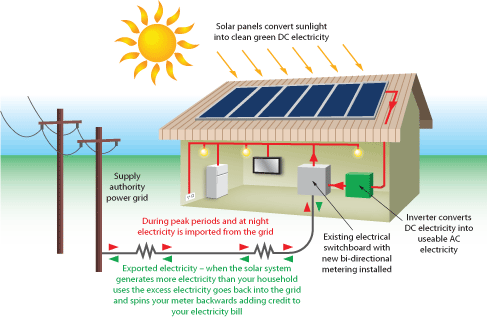Getting Started
Resources | Getting Started
Solar energy popularity has continued to expand as we watch the price of our electric bills go up almost daily.
Many of us have realized just how finite our supply of oil and coal really are. As the technology for photovoltaic (solar electric) panels improve, so do prices. The federal government offers incentives, as do many state governments, local agencies, and utility companies. And many states now have even legislated a feed-in tariff designed to encourage more people to invest in their own solar power generation array and sell the excess back to the power company.
The following steps are all it takes to set-up your own residential solar panels, and start doing what you can to help save the environment. When you get solar panels, you are going to be saving a ton of money on energy costs as well.
Step 1 – Initial Consultation: Evaluation of your electrical usage for 12 months and survey the site. It is our number one goal to bring you efficient and cost effective solar power for many years to come. To achieve this, we incorporate the highest standard of solar power technology of into our assessment.
Step 2 – Design & Engineering: Our commercial engineers will make use of laser imaging to plan your solar installation layout. This technology results in a more exacting design for your solar power system.
Step 3 – Installation: Our professional solar panel installers install solar panel systems in Los Angeles County, Orange County, Riverside County, San Bernardino County and in San Diego County.
Step 4 – Maintenance & Monitor: The monitoring of a commercial green power system is a comprehensive web-based interactive system that allows you to track your solar system’s energy output and overall energy performance. With real-time performance data, the monitoring system is the ideal solution for a commercial customer, government agency, water district, school, military, or agricultural facility.

Solar electricity is created by using Photovoltaic (PV) technology to convert sunlight into electricity. Photovoltaic systems use sunlight to power ordinary electrical equipment, for example, household appliances, computers and lighting. The photovoltaic (PV) process converts free solar energy – the most abundant energy source on the planet – directly into solar power. Note that this is not the familiar “passive” or Solar electricity thermal technology used for space heating and hot water production. PV equipment has no moving parts and as a result requires minimal maintenance. It generates solar electricity without producing emissions of greenhouse or any other gases, and its operation is virtually silent.
What is PV power used for?
PV systems supply solar electricity to many applications, ranging from systems supplying power to city buildings (which are also connected to the normal local solar power network) to systems supplying power to garden lights or to remote telecom relay stations.

The main area of interest today is grid connect PV systems. These systems are connected to the local solar electricity network. This means that during the day, the solar electricity generated by the PV system can either be used immediately (which is normal for systems installed on offices and other commercial buildings), or can be sold to one of the electricity supply companies (which is more common for domestic systems where the occupier may be out during the day). In the evening, when the electrical system is unable to provide the electricity required, power can be bought back from the network. In effect, the grid is acting as a Solar electricity energy storage system, which means the PV system does not need to include battery storage.
PV systems can be incorporated into buildings in various ways. Sloping rooftops are an ideal site, where modules can simply be mounted using frames. Photovoltaic systems can also be incorporated into the actual building fabric, for example PV roof tiles are now available which can be fitted as would standard tiles. In addition, PV can also be incorporated as building facades, canopies and sky lights amongst many other applications.
Stand-alone photovoltaic systems have been used for many years to supply solar electricity to applications where grid solar power supplies are unavailable or difficult to connect to. Examples include monitoring stations, radio repeater stations, telephone kiosks and street lighting. There is also a substantial market for PV technology in the leisure industry, with battery chargers for boats and caravans, as well as for powering garden equipment such as solar electricity fountains. These systems normally use batteries to store the solar power, if larger amounts are required they can be combined with another source of power – a biomass generator, a wind turbine or diesel generator to form a hybrid power supply system.


